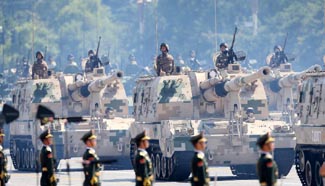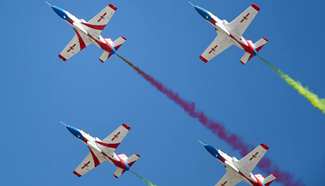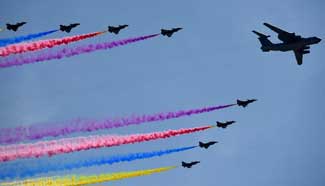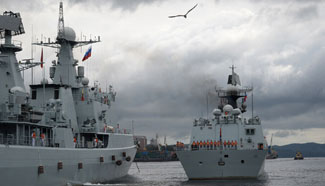????At 3 p.m. on June 2, in the Yangtze River off Jianli County, Hubei Province, where the Eastern Star cruise ship had capsized, a diver popped up from the water with bloodshot eyes and an oil-stained face. After rising too fast from the bottom of the river, his nose was bleeding. Catching a life buoy thrown by his comrade, he swam towards to the ship. The young man was Guan Dong. He had just rescued two passengers from the upturned vessel. “The moment I popped up from the water, I felt I had escaped from hell,” he said.
????Time and time again, they dived in those distressing waters.
????On the sixth floor of the People’s Hospital of Jianli, Zhu Hongmei had just been transferred from the intensive care unit to a standard ward. She kept murmuring thanks to Guan Dong and asking to see him.
????Guan Dong heard of the request and rushed to the hospital after finishing his shift at the disaster site. On his arrival, Zhu could not hold her tears. “Thank your parents for having such an excellent person,” she said. Guan Dong wept too. Having returned from the brink of death together, they embraced.
????When the diving squad of the Naval University of Engineering had arrived at the disaster site at 11:20 a.m. on June 2, Guan Dong had volunteered to dive first. The water was flowing fast and visibility was very low. Even the flashlight beam failed to extend the length of his arm.
????At midday, Guan Dong put on his equipment and dived into the capsized ship. He found 65-year-old Zhu surviving on the thin air inside her cabin. He smashed open the door and crawled in with difficultly. Seeing the diver, Zhu burst into tears. To calm her down and get her cooperation, Guan Dong comforted her: “Grandma, don’t cry. Take me as your grandson. I will take you out.”
????While comforting her, Guan Dong reported his discovery to the crew on the surface. Another diver brought rescue equipment to the cabin. Guan Dong and his partner guided Zhu out. Guan gave her his diving helmet. He only used breathing gear.
????Step by step, they struggled out. “They are coming out!” The awaiting crew exclaimed when Zhu Hongmei emerged from the river 15 hours after the ship capsized.
????At 2:15 p.m. on June 2, the life-detection machine beeped again. Guan Dong dived again.
????When a light flashed across the stifling cabin, 21-year-old Chen Shuhan had hope that he might live. Eighteen hours had passed. Chen told himself to keep standing. “Take it easy, buddy. I am by your side,” said Guan Dong, approaching him. Chen was unable to contain himself. “You know we just saved an old woman,” Guan told him, before reporting the news to the surface. “Hold on.”
????Chen’s oil-stained face was drawn with the immense physical and mental strain. Guan took off his diving equipment, including the breathing mask and helped Chen put them on. After Chen calmed down, Guan guided him out of the cabin and asked two divers help him out of the water.
????When the fragile Chen Shuhan emerged from the water, his eyes sparkled.
????Deep in the water, Guan Dong had been whirled around by unexpected currents. The signal rope on his body tangled with the boat. As his air was almost depleted, Guan Dong cut the rope and cast away the heavy diving equipment and the empty air bottle, and held his breath for a long ascent.
????The second day, the news of Guan Dong’s rescue missions, and those of the other 100 divers, was widely reported. But few knew how they had swum in those dangerous waters time and time again from June 2 to 10. The fearless divers had honored the duty of the Chinese navy in disaster prevention and rescue.
????Without modern equipment, we thrive on work style and tradition.
????Established in 1955 under the North Sea Fleet, the disaster prevention and rescue brigade was the first of its kind of the PLA Navy. It comprises 138 personnel and four 30-tonne diving vessels. The brigade has completed hundreds of missions, including search and rescue, salvage, offshore towing, flood prevention in the Liujiaxia Reservoir, retrieving an old Soviet tank from under the ice off the Zhenbao Island, the search for Japanese transport ship Awa Maru, and logistics for the launch of the Shenzhen series of spacecraft.
????Zhou Zhonghe is one of the brigade’s three top divers. Once during a trial of training equipment under development, the device sank 74 meters to the seabed, much deeper than the maximum diving depth of 60 meters. If the equipment was left there, researchers would have been unable secure its experimental data and the research would have been delayed. Any diver retrieving it would risk central nerve damage or even lung rupture. Still Zhou jumped into the water. He spent 20 minutes positioning the device. To stay sober, Zhou bit his tongue and lips. He set three new records, including the maximum depth on conventional diving equipment.
????Once after an air crash, Zhou and his comrades worked around the clock in three shifts for 11 days and nights before finally retrieving the black box. When they got ashore, all of them found their hands were injured. “Although our equipment is not cutting edge and our unit is not large, we carry out our duties with the work style and tradition passed on from the first generation of the unit,” he says.
????As the navy expands its operations, vessels alone can not ensure the efficiency and success of rescue missions. A number of sea powers have begun to develop aviation rescue, which can swiftly and accurately parachute the personnel, equipment and supplies necessary to the target waters, communicate directly with shore command and mobilize support units. This is particularly essential in rescue operations on the open sea. Against such a backdrop, the PLA established its first aviation rescue squad in August 2013.
????“Our members have specialties including diving, sailing and electronics. Our job is to secure survival of the victims so they can wait for subsequent help and treatment,” says squad chief Han Chun. “Our unit is young, but our work style and tradition are time-honored.”
????Exchanges broaden horizons and knowledge.
????With equipment weighing tens of kilograms on his back, Ni Lei dived 6 to 7 meters down on his first try. “It’s not a big deal being a diver,” he thought. But after a variety of tests and challenges, Ni and his team mates knew they must be fearless and constantly test new boundaries.
????In the pressure cabin where a steamed bun can flatten like a pancake, divers normally have to stay for 31 hours at a pressure equivalent to a depth of 480 meters. They must cope with high-pressure nerve syndrome and complete a variety of tests such as doing up their buttons and bicycle riding. In 2010, Ni Lei and three other divers set an Asian record of 480 meters in simulated saturation diving. “It proves Chinese divers are competent at underwater operations at different depths,” Ni said afterwards.
????Ni Lei is an elite diver of a mobile rescue brigade of the East Sea Fleet. In 2014, he took part in an exchange with U.S. and Australian divers during the RIMPAC exercise.
????“It was our first contact with American divers. They don’t know much about our abilities. So our training started with shallow diving, like that for new recruits. Once we met their standards, we moved to wreckage search at sea and simulated the salvage of crashed aircraft,” he recalls. The United States Navy does have a lot to recommend it in rescue operation procedures, he says.
????Ni, in his early thirties, has a rank equivalent to master sergeant. In the U.S. Navy, those who hold that rank are normally aged over 40 and their expertise is esteemed. “They have to work in at least four different departments and spend no more than three years in each post. Moreover, an eligible candidate for the rank must have been posted overseas for more than two years. Their master sergeants are proficient at command, logistics and field operations. Each of them can command three divers,” he says.
????Once after it rained, the Chinese personnel gave their tents a thorough airing. The tidy interiors of their tents impressed their U.S. peers. “This is routine for us,” says Ni. “The fact that they were impressed indicates that our exchanges are limited. Through such large-scale joint exercises and exchanges, we can enhance mutual understanding and trust and cement our friendship to make it as broad and deep as the sea.”

















